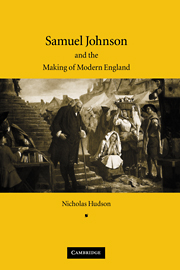Book contents
- Frontmatter
- Contents
- Acknowledgments
- Introduction
- 1 From “rank” to “class”: the changing structures of social hierarchy
- 2 Constructing the middle-class woman
- 3 From “Broad-bottom” to “party”: the rise of modern English politics
- 4 “The voice of the nation”: the evolution of the “public”
- 5 The construction of English nationhood
- 6 The material and ideological development of the British Empire
- Conclusion
- Notes
- Bibliography
- Index
2 - Constructing the middle-class woman
Published online by Cambridge University Press: 31 August 2009
- Frontmatter
- Contents
- Acknowledgments
- Introduction
- 1 From “rank” to “class”: the changing structures of social hierarchy
- 2 Constructing the middle-class woman
- 3 From “Broad-bottom” to “party”: the rise of modern English politics
- 4 “The voice of the nation”: the evolution of the “public”
- 5 The construction of English nationhood
- 6 The material and ideological development of the British Empire
- Conclusion
- Notes
- Bibliography
- Index
Summary
MIDDLE-CLASS IDENTITY AND THE NEW PUBLIC WOMAN
The creation of that monolithic category “the middle class” resulted from a lengthy process, as we have seen, bringing together, in uneasy alliance, the groups that had profited most from the great enrichment of England during the eighteenth century – the gentry, wealthy merchants and manufacturers, and professionals, all of whom ultimately found their common interests best protected through maintaining political union with the crown and the traditional nobility. This complex and fundamentally restive union required as well that the daughters and wives in these groups adopt a new role in the emerging social-political order. According to influential recent scholarship on the history of women, this role was, above all, domestic. Endorsing previous claims concerning the supposed expulsion of women from the world of work outside the home during the eighteenth century, this scholarship has maintained that women became increasingly confined to the “domestic sphere,” losing all influence over the public world of politics and professions that were now engrossed entirely by men. In the words of Leonore Davidoff and Catherine Hall, whose Family Fortunes: Men and Women of the English Middle-Class lent substantial authority to this thesis, “the equation of women with domesticity came to be one of the fixed points of middle-class status.” A weighty body of scholarship has since accumulated that portrays the eighteenth century as a time when women were increasingly confined to kitchen and drawing room, their heightened visibility as writers of novels and popular literature being small recompense for the hardening assumption that females were inherently destined to tend hearth and home.
- Type
- Chapter
- Information
- Samuel Johnson and the Making of Modern England , pp. 43 - 76Publisher: Cambridge University PressPrint publication year: 2003



